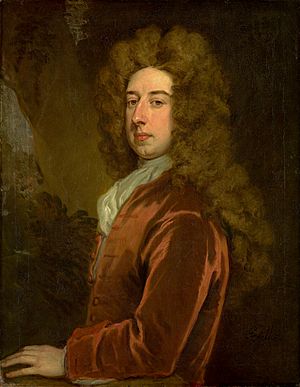5th Parliament of Great Britain facts for kids
Quick facts for kids 5th Parliament of Great Britain |
|||||||||||||||||
|---|---|---|---|---|---|---|---|---|---|---|---|---|---|---|---|---|---|
|
|||||||||||||||||

Spencer Compton, 1st Earl of Wilmington, Speaker of the House of Commons
|
|||||||||||||||||
| Overview | |||||||||||||||||
| Term | 17 March 1715 – 10 March 1722 | ||||||||||||||||
| Government |
|
||||||||||||||||
| House of Commons | |||||||||||||||||
| Members | 558 MPs | ||||||||||||||||
| Speaker of the House of Commons | Spencer Compton, 1st Earl of Wilmington | ||||||||||||||||
| House of Lords | |||||||||||||||||
| Leader of the House of Lords | |||||||||||||||||
| Sessions | |||||||||||||||||
|
|||||||||||||||||
The 5th Parliament of Great Britain was an important group of lawmakers. It was called together by George I of Great Britain on January 17, 1715. The Parliament officially started its work on March 17, 1715. It continued to meet until March 10, 1722. This Parliament was special because it was the first one to last for seven years. This longer term was set by a new law called the Septennial Act of 1716.
Contents
Understanding the Parliament's Makeup
The Parliament had two main parts: the House of Commons and the House of Lords. The House of Commons is where elected representatives, called Members of Parliament (MPs), debated and made laws. The House of Lords was made up of nobles and bishops.
Who Were the Whigs and Tories?
In the 1700s, there were two main political groups in Britain: the Whigs and the Tories. The Whigs generally supported the King and a stronger Parliament. The Tories often favored the traditional power of the King and the Church.
At the election for the 5th Parliament, the Whigs won a huge victory. They gained 341 seats in the House of Commons, while the Tories won 217. This was a big change from the previous election, where the Tories had won more seats.
Meet the Speaker
Spencer Compton, 1st Earl of Wilmington, a Whig MP from Sussex, was chosen as the Speaker of the House of Commons. The Speaker's job is to lead the debates and make sure the rules are followed.
Leaders of the Government
King George I mainly chose Whigs to run his government. This was because the Whigs had strongly supported him becoming King. Now, they also had the most support in the House of Commons.
Key Ministers in Power
Viscount Townshend became the King's main minister. He was the Secretary of State for the Northern Department and spoke for the government in the House of Lords. In the House of Commons, James Stanhope, the Secretary of State for the Southern Department, led the Whig government.
However, another important Whig, Robert Walpole, soon became very powerful. He was the Paymaster-general and Viscount Townshend's brother-in-law. In October 1715, Walpole was promoted to First Lord of the Treasury. This was a very important role, similar to being in charge of the country's money.
Changes in Leadership
The strong influence of Townshend and Walpole caused some disagreements within the Whig party. By early 1717, both of them had to leave their positions. Lord Sunderland took over from Townshend. He also became Lord President of the Council. In March 1718, Lord Sunderland became First Lord of the Treasury. This made him the most powerful person in the government, much like a Prime Minister today.
For the next three years, Lord Sunderland and James Stanhope led King George I's government together. Townshend and Walpole were no longer in power.
Return to Power
By 1721, things changed again. Lord Sunderland had moved to the House of Lords, and James Stanhope had passed away. Also, there was a big financial crisis called the South Sea Bubble. Because of these events, Townshend and Walpole were able to return to power. Townshend became Secretary of State again, and Walpole became First Lord of the Treasury, replacing Sunderland.
Important Laws Passed
Before the first session of Parliament ended, the Septennial Act was passed. This law made Parliaments last for seven years instead of three. This gave governments more time to work without needing new elections so often.
In 1719, there was an attempt to limit the King's power to create new nobles (peers). However, this idea was not approved by Parliament.
Key Laws from This Parliament
- Riot Act 1714: A law to help control large public gatherings and riots.
- Septennial Act 1715: The law that extended the life of Parliaments to seven years.
- Transportation Act 1717: A law that allowed criminals to be sent to colonies as punishment.
- Dependency of Ireland on Great Britain Act 1719: This law stated that the British Parliament had the right to make laws for Ireland.
- Royal Exchange and London Assurance Corporation Act 1719 (also known as the Bubble Act): This law was passed to control companies and prevent financial schemes like the South Sea Bubble.
See also
- 1715 British general election
- Townshend ministry 1714–1718
- First Stanhope–Sunderland ministry 1717–1718
- Second Stanhope–Sunderland ministry 1718-1721
- Walpole–Townshend ministry 1721–1730
- List of parliaments of Great Britain

